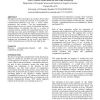2749 search results - page 68 / 550 » Physical Design of the |
VR
2010
IEEE
13 years 8 months ago
2010
IEEE
Children with autism show substantial benefits from rigorous physical activity, however it is often difficult to motivate these individuals to exercise due to their usually sede...
PIMRC
2008
IEEE
14 years 4 months ago
2008
IEEE
— The Internet of Things, emerging pervasive and sensor networks are low data-rate wireless networks with, a priori, no specific topology and no fixed infrastructure. Their pri...
CHI
2010
ACM
13 years 11 months ago
2010
ACM
Interacting with physical CDs can be a very tangible and explorative experience. However, physical objects can't provide access to the digital services we are used to when us...
DARE
2000
13 years 11 months ago
2000
This paper describes our progress in creating a device called a rototack. In its design, the rototack is an example of a computationally-enhanced craft item: a small, robust, inex...
EGICE
2006
14 years 1 months ago
2006
Situated design computing is an approach to the use of computers in design based on situated cognition. It is founded on two concepts: situatedness and constructive memory. These h...

